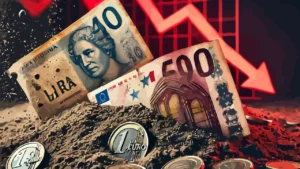In the 1970s, gold experienced a strong growth followed by a long period of stagnation. Many fear that a 30-year period without new highs could repeat itself, but the economic context has changed. Let’s analyze the differences and the reasons why this scenario seems unlikely.
Disclaimer:
The information provided does not constitute a solicitation for the placement of personal savings. The use of the data and information contained as support for personal investment operations is at the complete risk of the reader.
Contents
#1. Introduction
What happened in the 70s that was so important? The most sensational event occurred on August 15, 1971, when Nixon officially temporarily suspended (which later became definitively) the convertibility of the dollar into gold (for foreign countries). Why did I specify officially? Simple, because the quantity of dollars issued was already far superior to the underlying gold.
Nixon’s was only a formal act, made necessary by the enormous American debt and monetary aggregate that was beginning to accumulate and by the impossibility of satisfying all requests for the conversion of dollars into gold, under penalty of emptying all American gold reserves.
However, untying the dollar to its underlying gold, although it made many people turn up their noses, did not dethrone its prestige because it could count on another even more powerful underlying: oil.
In 1974, US Secretary of State Kissinger made a fifty-year agreement with the Saudi king: he would sell oil exclusively for dollars and reinvest the excess profits in US Treasury bonds. In return, he would receive weapons and military protection from Saudi Arabia.
It was a stroke of genius! Demand for crude oil was skyrocketing from all non-oil producing countries, especially after the 1973 oil crisis when the price of oil skyrocketed. All countries would have to buy dollars to buy oil, giving the United States of America great purchasing power while keeping the trade balance functional and allowing it to expand its debt more and more with the guarantee that it would be constantly purchased.
#2. The Gold Rush of the 1970s
Well, now that we have explained a little about what happened in that period, let’s move on to the data, let’s see how gold, silver, real estate and US stocks behaved in the reference decade:
- Gold: 25.1x
- Silver: 41.5x
- Real estate: 2.3x
- Dow Jones: 1.4x
#3. What has changed since the 1970s?
And now, in a scenario that I would not have even remotely imagined just 5 years ago, let’s see how the purchasing potential has changed compared to the same decade:
- Global access to precious metals purchase: 18x
- Amount of coins in circulation: 55x
- Number of millionaires: 56x
- Number of billionaires: 200x
- Amount of consumer credit available: 200x
- Amount of assets under management: 32x
- Stock Market Capitalization: 49x
…and wealth, which on average has grown for everyone, has accumulated disproportionately more in the hands of those who were already rich.
What do you think the rich will buy in large quantities to save their capital if they fear for it? If a sudden run on safe havens were to occur, what do you think would happen to the price of gold and silver this time??
#4. If it doesn’t rise for another 30 years?
One scenario that might scare people who want to buy gold right now is to see the price drop for another 30 years before returning to that value, as it did in the early 1980s.
This doubt is more than legitimate but I personally think that there is no need to worry. Let me explain…
When U.S. President Gerald Ford allowed Americans to own investment gold again on August 14, 1974 , after a three-year price retracement that had nearly quintupled since the 1970s, gold hit new highs, more than quadrupling its value since 1974.
The price of gold thus reaches $800 an ounce and then falls and does not touch the same value for the next 30 years, approximately until 2010.
However, we must take into account the particular situation that led to this price explosion. In the 70s the world scenario was very different from today and the countries that could be labeled as wealthy or where gold could be legally purchased were very few:
- United States of America (legal since ’74),
- Canada,
- Europe,
- Australia (legal since mid 1970s),
- New Zealand.
Today the story is different and wealth has increased greatly in all those countries that previously could not have contributed to the rush to buy gold.
Furthermore, the world’s economic engine was based in the United States, where capital could not flow into gold until 1974, which was the Americans’ preferred savings instrument.
At the same time, in the other countries on the list, gold did not have the same importance as a savings instrument.
It is therefore natural for me to deduce that as soon as the gates were reopened, the price skyrocketed. I would like to point out that silver also performed very well in those years, almost double that of gold.
Now, we are nowhere near this scenario, even if the price of gold continues to rise, as it has been doing for the past 14 years. In addition to the differences I listed in the previous chapter, keep in mind that for decades in all the countries in the world it is possible to buy gold (except in North Korea) and the amount of wealth is much more distributed than before.
For these reasons, I believe that there is no logical reason to worry about a possible new thirty-year period in which gold will no longer touch the maximum values it has reached.











Leave a Reply